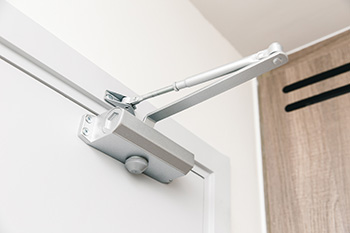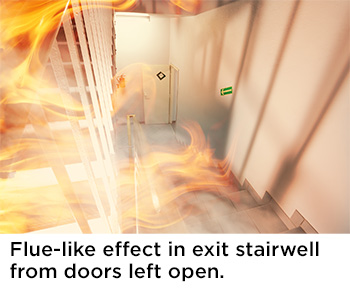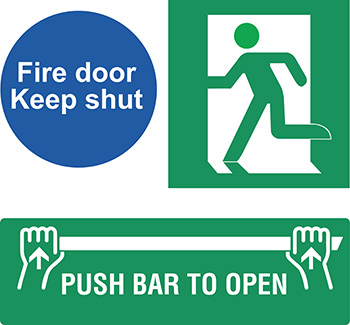Maintain fire doors and keep them closed

Fire doors are a life safety feature of buildings that are designed to limit the spread of fire and smoke. Yet, we have all seen fire doors propped open, removed, and in some cases, just not working properly to self-close.
According to the National Fire Protection Association (NFPA), public fire departments responded to nearly 1.4 million building fires in 2021.1 They also reported that a fire occurs in a building structure every 65 seconds. When a fire occurs, there is less smoke and fire damage when the fire doors are closed and in good working order. Here are some examples of reasons fire doors have been left open:
- To distribute heat or air conditioning to other sections of a building to save on utility costs.
- For the ease of movement throughout the building.
- It is easier to carry awkward or heavy objects into an enclosed stairwell if the door is left open.
- The self-closing door mechanism isn’t functioning properly.
- Tenants are moving in or out of the building with multiple trips and it’s easier to prop the doors open.
When fire doors are kept open, there is the potential for much greater loss of life. Tests by Underwriters Laboratory (UL) have concluded that today’s fires grow more rapidly inside buildings.2 A major factor for the faster growth in apartments, group homes and assisted living structures is that the interior finishes and furniture are more synthetic than years ago, when wood and cotton were predominantly used. Additionally, when synthetic materials burn, the smoke may contain more toxins and dangerous levels of chemical substances. Carbon Monoxide is another well-known substance produced in fires that may cause death, even in small amounts.

While it may be difficult to eliminate most of the materials that burn, property owners can prevent the fire and toxic smoke from spreading into exit paths by keeping the fire doors closed.
- Keep the fire doors closed to limit the spread of smoke and fire into the enclosed area the fire door was meant to protect.
- Fire doors should be inspected to assure that they function and fully close with the self-closing mechanism.
- Place signs on the doors that read “Fire Door – Keep Shut”.
- Educate your employees, residents and visitors about the importance of fire doors.
- Should doors be kept open for ease of access, automatic door closers should be interlocked with the fire/smoke alarm system and or the automatic sprinkler system flow alarm.

Residential programs such as group homes, apartments buildings, assisted living and skilled living occupancies are at an even greater risk for injuries and fatalities from fire doors left open. Not all the clients, patients or tenants may be able to exit on their own or they may need additional time to exit a building. This increases their chance of smoke inhalation or getting burned from a building fire.
According to NFPA, most deaths are the result of breathing in smoke rather than burns.3 Why is it so difficult for residents of homes or apartment type structures to escape from a fire? Smoke produced may be thick and impair vision to exits. Also, as a person inhales smoke, the oxygen in their system is displaced and they may become disoriented.

In January 2022, there was an apartment fire in the Bronx, NY where 17 people died, including 8 children. A fire inside an apartment unit on the 3rd floor spread when the tenant evacuated but left the unit’s door open. As the fire burned, smoke was drawn though a stairwell door that was also left open, creating a flue like effect inside that stairwell all the way up to the 15th floor. Per the responding fire department, all victims died of smoke inhalation.4
Building owners are responsible for keeping their fire door assemblies code compliant, regardless of whether the annual inspection requirements are being enforced. NFPA 80 provides 13 criteria for fire door inspections and stipulates that the doors must be annually inspected by a “qualified person”. They define a qualified person as “A person who, by possession of a recognized degree, certificate, professional standing, or skill, and who, by knowledge, training, and experience, has demonstrated the ability to deal with the subject matter, the work, or the project.”1 Inspecting fire doors and repairing any nonworking components can help save lives. Inspections can also save your company from being held liable for the lives of others and costly fines for non-compliance with fire life safety codes.
Please keep all fire doors closed and maintained. Someone else’s life depends on it.
References:
1 National Fire Protection Association: Fire Loss in the United States During 2021
2 Fire Safety Research Institute: New Comparison of Natural and Synthetic Home Furnishings
3 National Fire Protection Association: Reporter’s Guide – The Consequences of Fire
4 https://www.nytimes.com/2022/01/09/nyregion/nyc-bronx-fire.html
NFPA 101 Life Safety Code
NFPA 80 Standard for Fire Doors and Other Opening Protectives
